Analyzing the Effects of Planting Date on the Uncertainty of CERES-Maize and Its Potential to Reduce Yield Gap in Arid and Mediterranean Climates
Abstract
1. Introduction
2. Material and Methods
2.1. Area of Study
2.2. Crop Model and Platform
2.3. Input Data
2.4. Simulation Setup
2.5. Statistical Analysis
2.6. Comparison with Point-Based–CERES-Maize Data
2.7. Comparison with Optimum Total Biomass (No Water and No Nutrient Stress) Data
3. Results and Discussion
3.1. Crop Meteorology
3.2. The Temporal Effect on Different Planting Dates and Regions
3.3. Spatial Patterns of Means and Variability for TB, ETc, and WP
3.4. Comparison of pSIMS–CERES-Maize and Point-Based–CERES-Maize Result
3.5. Comparison of pSIMS–CERES-Maize and Experimental Data and Calculate Yield Gap
4. Conclusions
Supplementary Materials
Author Contributions
Funding
Data Availability Statement
Conflicts of Interest
References
- FAO. 2009. Available online: https://www.fao.org/3/i0680e/i0680e.pdf (accessed on 1 May 2023).
- Calzadilla, A.; Rehdanz, K.; Betts, R.; Falloon, P.; Wiltshire, A.; Tol, R.S. Climate change impacts on global agriculture. Clim. Chang. 2013, 120, 357–374. [Google Scholar] [CrossRef]
- Rosegrant, M.W.; Ringler, C.; Zhu, T. Water for agriculture: Maintaining food security under growing scarcity. Annu. Rev. Environ. Resour. 2009, 34, 205–222. [Google Scholar] [CrossRef]
- Borreani, G.; Tabacco, E. The relationship of silage temperature with the microbiological status of the face of corn silage bunkers. J. Dairy Sci. 2010, 93, 2620–2629. [Google Scholar] [CrossRef]
- Nilahyane, A.; Islam, M.A.; Mesbah, A.O.; Garcia y Garcia, A. Evaluation of silage corn yield gap: An approach for sustainable production in the semi-arid region of USA. Sustainability 2018, 10, 2523. [Google Scholar] [CrossRef]
- Saseendran, S.A.; Ahuja, L.R.; Ma, L.; Nielsen, D.C.; Trout, T.J.; Andales, A.A.; Chávez, J.L.; Ham, J. Enhancing the water stress factors for simulation of corn in RZWQM2. Agron. J. 2014, 106, 81–94. [Google Scholar] [CrossRef]
- Zhang, G.; Liu, C.; Xiao, C.; Xie, R.; Ming, B.; Hou, P.; Liu, G.; Xu, W.; Shen, D.; Wang, K.; et al. Optimizing water use efficiency and economic return of super high yield spring maize under drip irrigation and plastic mulching in arid areas of China. Field Crops Res. 2017, 211, 137–146. [Google Scholar] [CrossRef]
- Xiao, C.; Zou, H.; Fan, J.; Zhang, F.; Li, Y.; Sun, S.; Pulatov, A. Optimizing irrigation amount and fertilization rate of drip-fertigated spring maize in northwest China based on multi-level fuzzy comprehensive evaluation model. Agric. Water Manag. 2021, 257, 107157. [Google Scholar] [CrossRef]
- Boote, K.J.; Jones, J.W.; Hoogenboom, G.; White, J.W. The role of crop systems simulation in agriculture and environment. Int. J. Agric. Environ. Inf. Syst. 2010, 1, 41–54. [Google Scholar] [CrossRef]
- Hoogenboom, G. Contribution of agrometeorology to the simulation of crop production and its applications. Agric. For. Meteorol. 2000, 103, 137–157. [Google Scholar] [CrossRef]
- Brisson, N.; Gary, C.; Justes, E.; Roche, R.; Mary, B.; Ripoche, D.; Zimmer, D.; Sierra, J.; Bertuzzi, P.; Burger, P.; et al. An overview of the crop model STICS. Eur. J. Agron. 2003, 18, 309–332. [Google Scholar] [CrossRef]
- Holzworth, D.P.; Huth, N.I.; deVoil, P.G.; Zurcher, E.J.; Herrmann, N.I.; McLean, G.; Chenu, K.; van Oosterom, E.J.; Snow, V.; Murphy, C.; et al. APSIM–evolution towards a new generation of agricultural systems simulation. Environ. Model. Softw. 2014, 62, 327–350. [Google Scholar] [CrossRef]
- Stöckle, C.O.; Donatelli, M.; Nelson, R. CropSyst, a cropping systems simulation model. Eur. J. Agron. 2003, 18, 289–307. [Google Scholar] [CrossRef]
- De Wit, A.; Boogaard, H.; Fumagalli, D.; Janssen, S.; Knapen, R.; van Kraalingen, D.; Supit, I.; van der Wijngaart, R.; van Diepen, K. 25 years of the WOFOST cropping systems model. Agric. Syst. 2019, 168, 154–167. [Google Scholar] [CrossRef]
- Jones, J.W.; Hoogenboom, G.; Porter, C.H.; Boote, K.J.; Batchelor, W.D.; Hunt, L.A.; Wilkens, P.W.; Singh, U.; Gijsman, A.J.; Ritchie, J.T. The DSSAT cropping system model. Eur. J. Agron. 2003, 18, 235–265. [Google Scholar] [CrossRef]
- Hoogenboom, G.; Porter, C.H.; Shelia, V.; Boote, K.J.; Singh, U.; White, J.W.; Pavan, W.; Oliveira, F.A.A.; Moreno-Cadena, L.P.; Lizaso, J.I.; et al. Decision Support System for Agrotechnology Transfer (DSSAT), Version 4.8; (DSSAT.net); DSSAT Foundation: Gainesville, FL, USA, 2021. [Google Scholar]
- Jones, J.W.; Antle, J.M.; Basso, B.; Boote, K.J.; Conant, R.T.; Foster, I.; Godfray, H.C.J.; Herrero, M.; Howitt, R.E.; Janssen, S.; et al. Brief history of agricultural systems modeling. Agric. Syst. 2017, 155, 240–254. [Google Scholar] [CrossRef]
- Jones, C.A.; Kiniry, J.R. (Eds.) CERES-Maize: A Simulation Model of Maize Growth and Development; Texas A&M University Press: College Station, TX, USA, 1986. [Google Scholar]
- Song, L.; Jin, J. Improving CERES-Maize for simulating maize growth and yield under water stress conditions. Eur. J. Agron. 2020, 117, 126072. [Google Scholar] [CrossRef]
- Malik, W.; Isla, R.; Dechmi, F. DSSAT-CERES-maize modelling to improve irrigation and nitrogen management practices under Mediterranean conditions. Agric. Water Manag. 2019, 213, 298–308. [Google Scholar] [CrossRef]
- Walker, W.E.; Harremoës, P.; Rotmans, J.; Van Der Sluijs, J.P.; Van Asselt, M.B.; Janssen, P.; Krayer von Krauss, M.P. Defining uncertainty: A conceptual basis for uncertainty management in model-based decision support. Integr. Assess. 2003, 4, 5–17. [Google Scholar] [CrossRef]
- Tao, F.; Rötter, R.P.; Palosuo, T.; Gregorio Hernández Díaz-Ambrona, C.; Mínguez, M.I.; Semenov, M.A.; Kersebaum, K.C.; Nendel, C.; Specka, X.; Hoffmann, H.; et al. Contribution of crop model structure, parameters and climate projections to uncertainty in climate change impact assessments. Glob. Chang. Biol. 2018, 24, 1291–1307. [Google Scholar] [CrossRef]
- Han, E.; Ines, A.V.; Baethgen, W.E. Climate-Agriculture-Modeling and Decision Tool (CAMDT): A software framework for climate risk management in agriculture. Environ. Model. Softw. 2017, 95, 102–114. [Google Scholar] [CrossRef]
- Lobell, D.B.; Asseng, S. Comparing estimates of climate change impacts from process-based and statistical crop models. Environ. Res. Lett. 2017, 12, 015001. [Google Scholar] [CrossRef]
- Ramirez-Villegas, J.; Koehler, A.K.; Challinor, A.J. Assessing uncertainty and complexity in regional-scale crop model simulations. Eur. J. Agron. 2017, 88, 84–95. [Google Scholar] [CrossRef]
- Ojeda, J.J.; Rezaei, E.E.; Kamali, B.; McPhee, J.; Meinke, H.; Siebert, S.; Webb, M.A.; Ara, I.; Mulcahy, F.; Ewert, F. Impact of crop management and environment on the spatio-temporal variance of potato yield at regional scale. Field Crops Res. 2021, 270, 108213. [Google Scholar] [CrossRef]
- Dokoohaki, H.; Kivi, M.S.; Martinez-Feria, R.; Miguez, F.E.; Hoogenboom, G. A comprehensive uncertainty quantification of large-scale process-based crop modeling frameworks. Environ. Res. Lett. 2021, 16, 084010. [Google Scholar] [CrossRef]
- Tao, F.; Zhang, Z. Climate change, high-temperature stress, rice productivity, and water use in Eastern China: A new superensemble-based probabilistic projection. J. Appl. Meteorol. Climatol. 2013, 52, 531–551. [Google Scholar] [CrossRef]
- Wu, R.; Lawes, R.; Oliver, Y.; Fletcher, A.; Chen, C. How well do we need to estimate plant-available water capacity to simulate water-limited yield potential? Agric. Water Manag. 2019, 212, 441–447. [Google Scholar] [CrossRef]
- Teixeira, E.I.; Zhao, G.; de Ruiter, J.; Brown, H.; Ausseil, A.G.; Meenken, E.; Ewert, F. The interactions between genotype, management and environment in regional crop modelling. Eur. J. Agron. 2017, 88, 106–115. [Google Scholar] [CrossRef]
- Folberth, C.; Elliott, J.; Müller, C.; Balkovic, J.; Chryssanthacopoulos, J.; Izaurralde, R.C.; Jones, C.D.; Khabarov, N.; Liu, W.; Reddy, A.; et al. Uncertainties in global crop model frameworks: Effects of cultivar distribution, crop management and soil handling on crop yield estimates. Biogeosci. Discuss. 2016, 1–30. [Google Scholar] [CrossRef]
- Gheysari, M.; Sadeghi, S.H.; Loescher, H.W.; Amiri, S.; Zareian, M.J.; Majidi, M.M.; Asgarinia, P.; Payero, J.O. Comparison of deficit irrigation management strategies on root, plant growth and biomass productivity of silage maize. Agric. Water Manag. 2017, 182, 126–138. [Google Scholar] [CrossRef]
- Gheysari, M.; Pirnajmedin, F.; Movahedrad, H.; Majidi, M.M.; Zareian, M.J. Crop yield and irrigation water productivity of silage maize under two water stress strategies in semi-arid environment: Two different pot and field experiments. Agric. Water Manag. 2021, 255, 106999. [Google Scholar] [CrossRef]
- Dokoohaki, H.; Gheysari, M.; Mousavi, S.F.; Zand-Parsa, S.; Miguez, F.E.; Archontoulis, S.V.; Hoogenboom, G. Coupling and testing a new soil water module in DSSAT CERES-Maize model for maize production under semi-arid condition. Agric. Water Manag. 2016, 163, 90–99. [Google Scholar] [CrossRef]
- Mohamadzade, F.; Gheysari, M.; Eshghizadeh, H.; Tabatabaei, M.S.; Hoogenboom, G. The effect of water and nitrogen on drip tape irrigated silage maize grown under arid conditions: Experimental and simulations. Agric. Water Manag. 2022, 271, 107821. [Google Scholar] [CrossRef]
- Angulo, C.; Rötter, R.; Trnka, M.; Pirttioja, N.; Gaiser, T.; Hlavinka, P.; Ewert, F. Characteristic ‘fingerprints’ of crop model responses to weather input data at different spatial resolutions. Eur. J. Agron. 2013, 49, 104–114. [Google Scholar] [CrossRef]
- Chen, S.; Jiang, T.; Ma, H.; He, C.; Xu, F.; Malone, R.W.; Feng, H.; Yu, Q.; Siddique, K.H.; He, J. Dynamic within-season irrigation scheduling for maize production in Northwest China: A Method Based on Weather Data Fusion and yield prediction by DSSAT. Agric. For. Meteorol. 2020, 285, 107928. [Google Scholar] [CrossRef]
- Tofa, A.I.; Chiezey, U.F.; Babaji, B.A.; Kamara, A.Y.; Adnan, A.A.; Beah, A.; Adam, A.M. Modeling planting-date effects on intermediate-maturing maize in contrasting environments in the Nigerian Savanna: An Application of DSSAT Model. Agronomy 2020, 10, 871. [Google Scholar] [CrossRef]
- Attia, A.; El-Hendawy, S.; Al-Suhaibani, N.; Tahir, M.U.; Mubushar, M.; dos Santos Vianna, M.; Ullah, H.; Mansour, E.; Datta, A. Sensitivity of the DSSAT model in simulating maize yield and soil carbon dynamics in arid Mediterranean climate: Effect of soil, genotype and crop management. Field Crops Res. 2021, 260, 107981. [Google Scholar] [CrossRef]
- Fry, J.; Guber, A.K.; Ladoni, M.; Munoz, J.D.; Kravchenko, A.N. The effect of up-scaling soil properties and model parameters on predictive accuracy of DSSAT crop simulation model under variable weather conditions. Geoderma 2017, 287, 105–115. [Google Scholar] [CrossRef]
- de Martonne, E. Une nouvelle function climatologique: L’indice d’aridité. Meteorologie 1926, 2, 449–459. [Google Scholar]
- Yaghmaei, L.; Soltani, S.; Khodagholi, M. Bioclimatic classification of Isfahan province using multivariate statistical methods. Int. J. Climatol. 2009, 29, 1850–1861. [Google Scholar] [CrossRef]
- Hoogenboom, G.; Porter, C.H.; Boote, K.J.; Shelia, V.; Wilkens, P.W.; Singh, U.; White, J.W.; Asseng, S.; Lizaso, J.I.; Moreno, L.P.; et al. The DSSAT crop modeling ecosystem. In Advances in Crop Modelling for a Sustainable Agriculture; Burleigh Dodds Science Publishing: Cambridge, UK, 2019. [Google Scholar]
- Elliott, J.; Kelly, D.; Chryssanthacopoulos, J.; Glotter, M.; Jhunjhnuwala, K.; Best, N.; Wilde, M.; Foster, I. The parallel system for integrating impact models and sectors (pSIMS). Environ. Model. Softw. 2014, 62, 509–516. [Google Scholar] [CrossRef]
- Hengl, T.; Mendes de Jesus, J.; Heuvelink, G.B.; Ruiperez Gonzalez, M.; Kilibarda, M.; Blagotić, A.; Shangguan, W.; Wright, M.N.; Geng, X.; Bauer-Marschallinger, B.; et al. SoilGrids250m: Global gridded soil information based on machine learning. PLoS ONE 2017, 12, e0169748. [Google Scholar] [CrossRef]
- Shangguan, W.; Dai, Y.; Duan, Q.; Liu, B.; Yuan, H. A global soil data set for earth system modeling. J. Adv. Model. Earth Syst. 2014, 6, 249–263. [Google Scholar] [CrossRef]
- Hersbach, H.; Bell, B.; Berrisford, P.; Hirahara, S.; Horányi, A.; Muñoz-Sabater, J.; Nicolas, J.; Peubey, C.; Radu, R.; Schepers, D.; et al. The ERA5 global reanalysis. Q. J. R. Meteorol. Soc. 2020, 146, 1999–2049. [Google Scholar] [CrossRef]
- IBM Corporation. IBM SPSS Statistics; IBM Corporation: Armonk, NY, USA, 2017. [Google Scholar]
- Tabatabaei, M. Investigation of Water and Nitrogen Use Efficiency and Yield of Silage Maize under Drip-Tape Irrigation Management. Master’s Thesis, Department of Water Engineering, College of Agriculture, Isfahan University of Technology, Isfahan, Iran, 2017. (In Persian). [Google Scholar]
- Domroes, M.; El-Tantawi, A. Recent temporal and spatial temperature changes in Egypt. Int. J. Climatol. 2005, 25, 51–63. [Google Scholar] [CrossRef]
- Sun, H.; Zhang, X.; Wang, E.; Chen, S.; Shao, L.; Qin, W. Assessing the contribution of weather and management to the annual yield variation of summer maize using APSIM in the North China Plain. Field Crops Res. 2016, 194, 94–102. [Google Scholar] [CrossRef]
- Ray, D.K.; Gerber, J.S.; MacDonald, G.K.; West, P.C. Climate variation explains a third of global crop yield variability. Nat. Commun. 2015, 6, 5989. [Google Scholar] [CrossRef] [PubMed]
- Lobell, D.B.; Hammer, G.L.; McLean, G.; Messina, C.; Roberts, M.J.; Schlenker, W. The critical role of extreme heat for maize production in the United States. Nat. Clim. Chang. 2013, 3, 497–501. [Google Scholar] [CrossRef]
- Suyker, A.E.; Verma, S.B. Evapotranspiration of irrigated and rainfed maize–soybean cropping systems. Agric. For. Meteorol. 2009, 149, 443–452. [Google Scholar] [CrossRef]
- Saseendran, S.A.; Ma, L.; Nielsen, D.C.; Vigil, M.F.; Ahuja, L.R. Simulating planting date effects on crop production using RZWQM and CERES-maize models. Agron. J. 2005, 97, 58–71. [Google Scholar]
- Lindquist, J.L.; Arkebauer, T.J.; Walters, D.T.; Cassman, K.G.; Dobermann, A. Maize radiation use efficiency under optimal growth conditions. J. Agron. 2005, 97, 72–78. [Google Scholar] [CrossRef]
- Chapagain, R.; Remenyi, T.A.; Harris, R.M.; Mohammed, C.L.; Huth, N.; Wallach, D.; Rezaei, E.E.; Ojeda, J.J. Decomposing crop model uncertainty: A systematic review. Field Crops Res. 2022, 279, 108448. [Google Scholar] [CrossRef]
- Li, T.; Hasegawa, T.; Yin, X.; Zhu, Y.; Boote, K.; Adam, M.; Bregaglio, S.; Buis, S.; Confalonieri, R.; Fumoto, T.; et al. Uncertainties in predicting rice yield by current crop models under a wide range of climatic conditions. Glob. Chang. Biol. 2015, 21, 1328–1341. [Google Scholar] [CrossRef] [PubMed]
- Asseng, S.; Ewert, F.; Rosenzweig, C.; Jones, J.; Hatfield, J.; Ruane, A.; Boote, K.; Thorburn, P.; Rötter, R.; Cammarano, D. Uncertainty in simulating wheat yield. Nat. Clim. Chang. 2013, 3, 827–832. [Google Scholar] [CrossRef]
- Malhi, G.S.; Kaur, M.; Kaushik, P. Impact of climate change on agriculture and its mitigation strategies: A review. Sustainability 2021, 13, 1318. [Google Scholar] [CrossRef]
- Zimmermann, A.; Webber, H.; Zhao, G.; Ewert, F.; Kros, J.; Wolf, J.; Britz, W.; de Vries, W. Climate change impacts on crop yields, land use and environment in response to crop sowing dates and thermal time requirements. Agric. Syst. 2017, 157, 81–92. [Google Scholar] [CrossRef]
- Mohamadzade, F. Plan of Agricultural Water Management with an Emphasis on the Increasing Water Use Efficiency of Maize in Isfahan Province Based on Field Research and Using DSSAT. Ph.D. Thesis, Department of Water Science and Engineering, College of Agriculture, Isfahan University of Technology, Isfahan, Iran, 2017. (In Persian). [Google Scholar]
- Jiao, D.; Xu, N.; Yang, F.; Xu, K. Evaluation of spatial-temporal variation performance of ERA5 precipitation data in China. Sci. Rep. 2021, 11, 17956. [Google Scholar] [CrossRef]
- Tarek, M.; Brissette, F.P.; Arsenault, R. Evaluation of the ERA5 reanalysis as a potential reference dataset for hydrological modelling over North America. Hydrol. Earth Syst. Sci. 2020, 24, 2527–2544. [Google Scholar] [CrossRef]
- Stoorvogel, J.J.; Mulder, V.L. A comparison, validation, and evaluation of the s-world global soil property database. Land 2021, 10, 544. [Google Scholar] [CrossRef]
- Huang, S.; Eisner, S.; Haddeland, I.; Mengistu, Z.T. Evaluation of two new-generation global soil databases for macro-scale hydrological modelling in Norway. J. Hydrol. 2022, 610, 127895. [Google Scholar] [CrossRef]
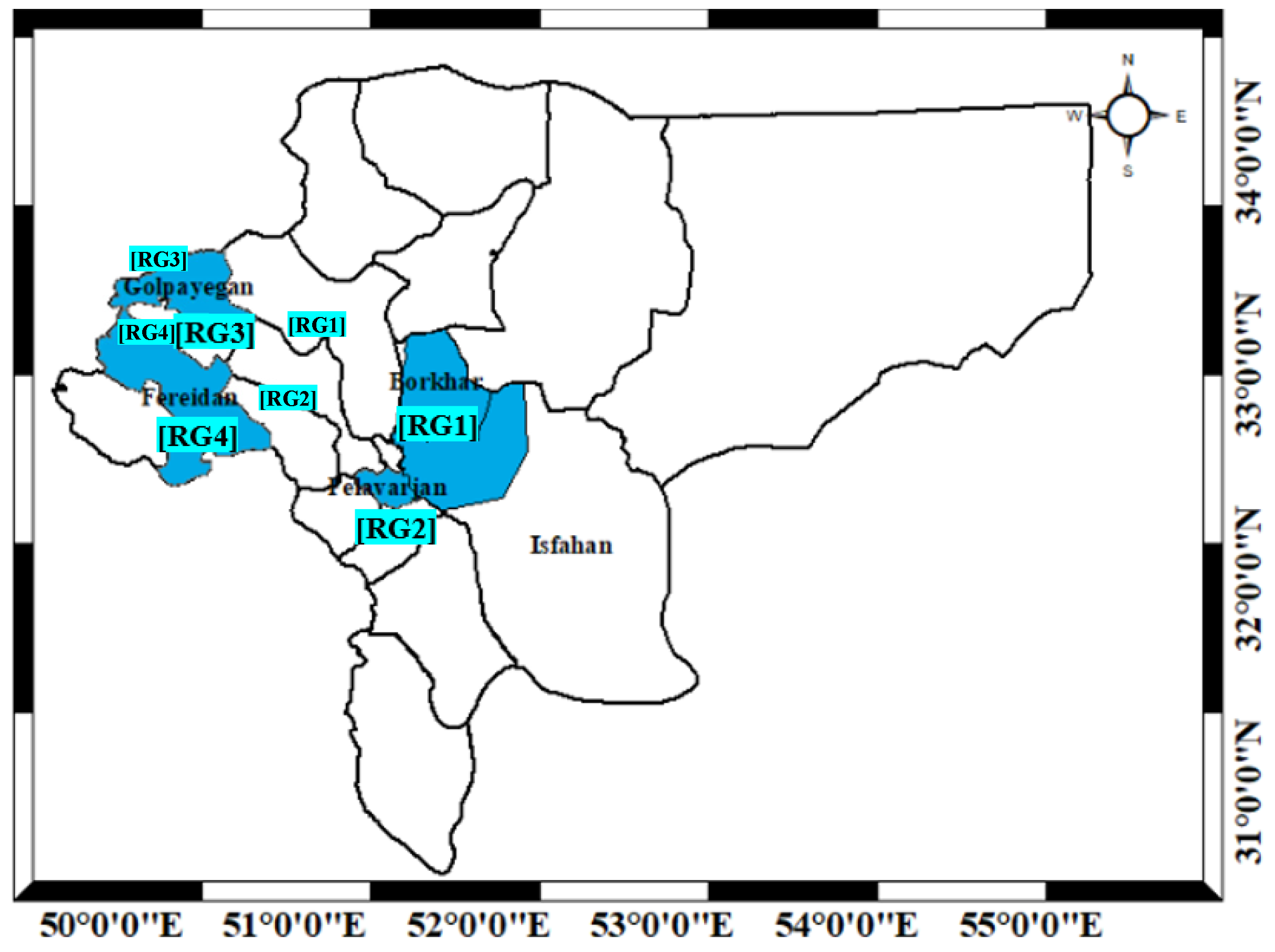


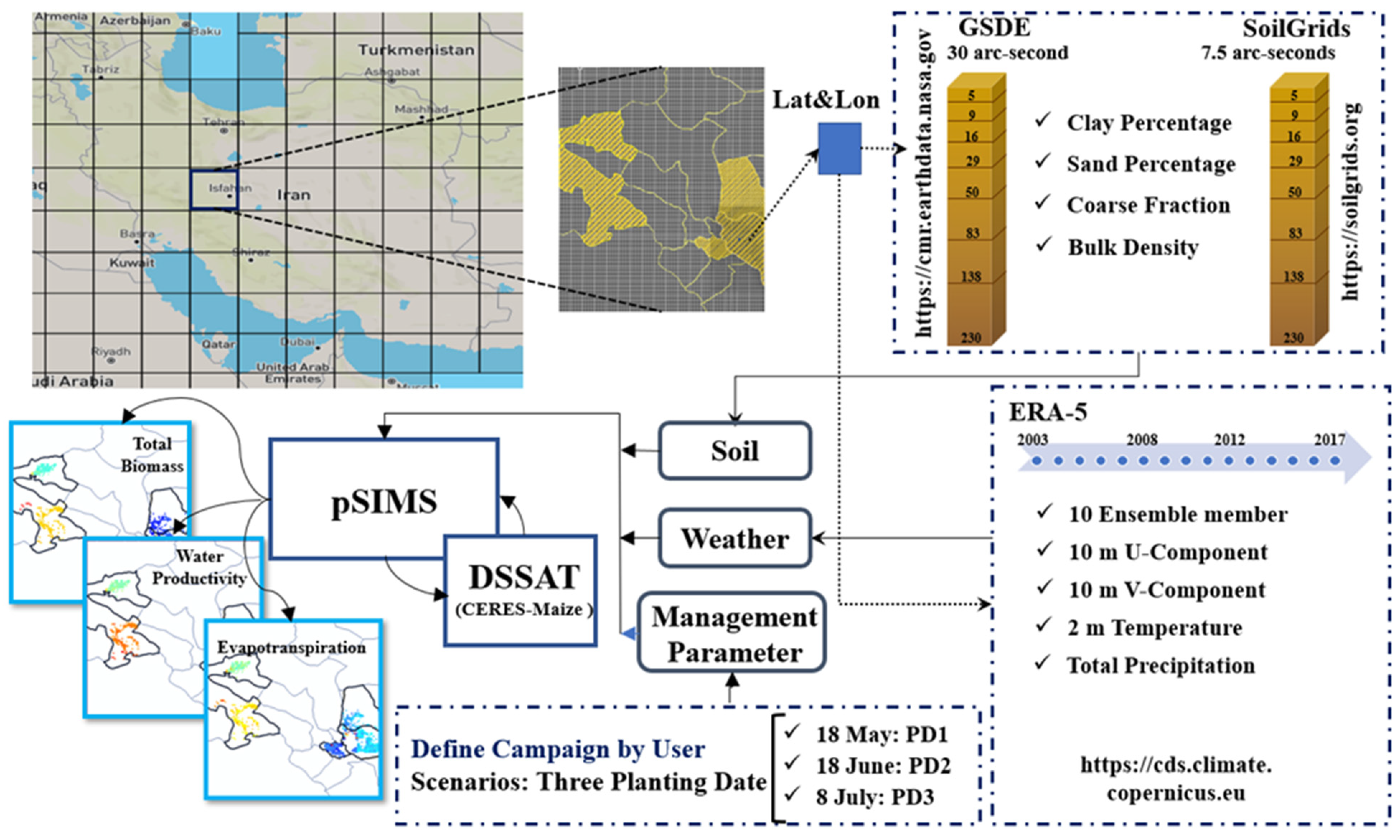

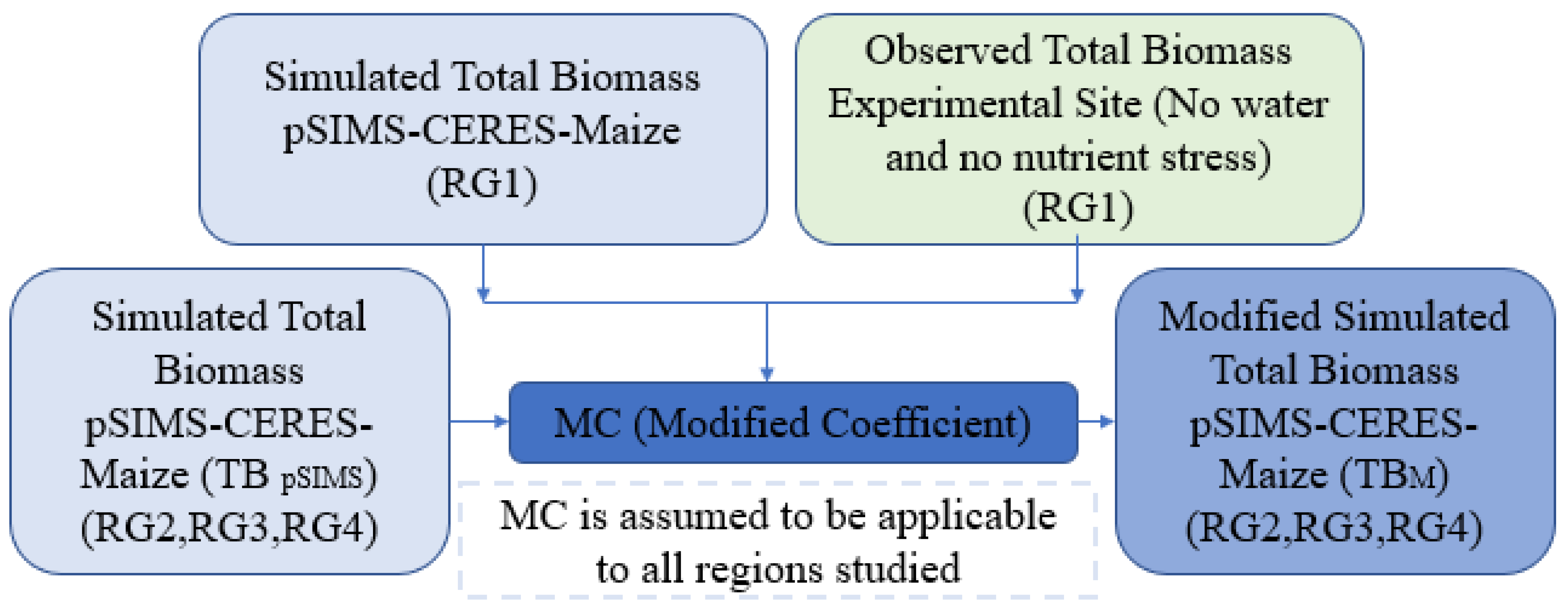
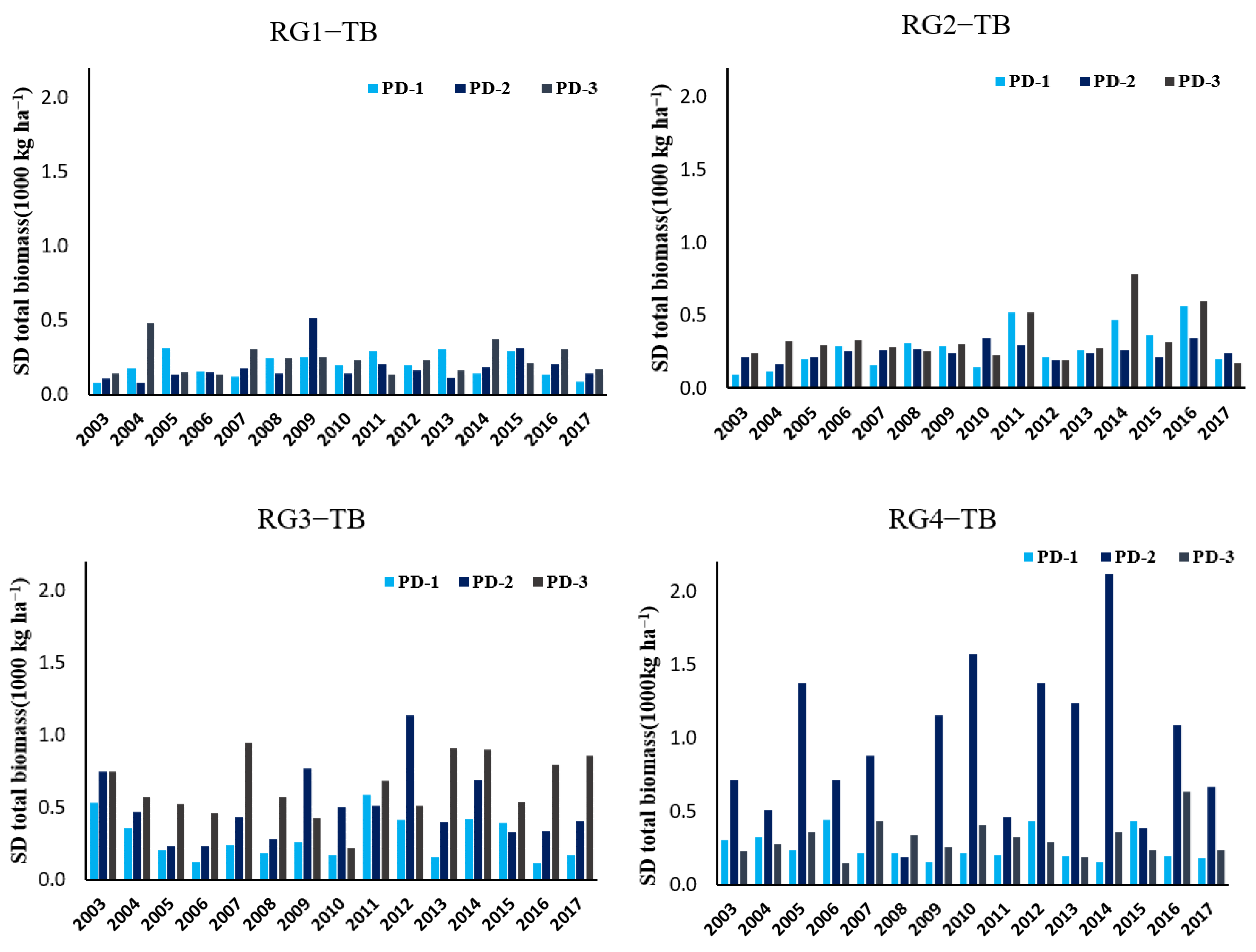
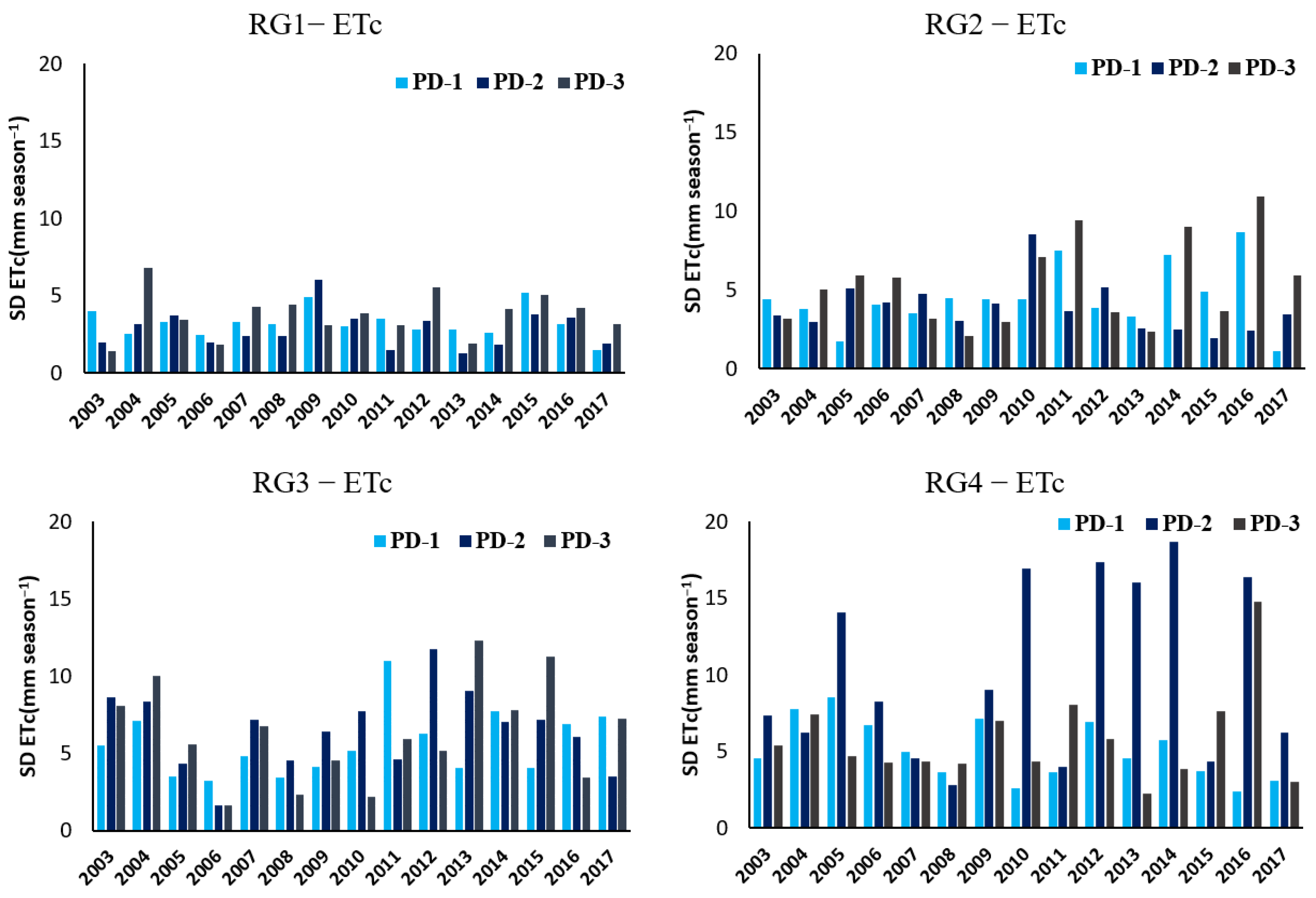

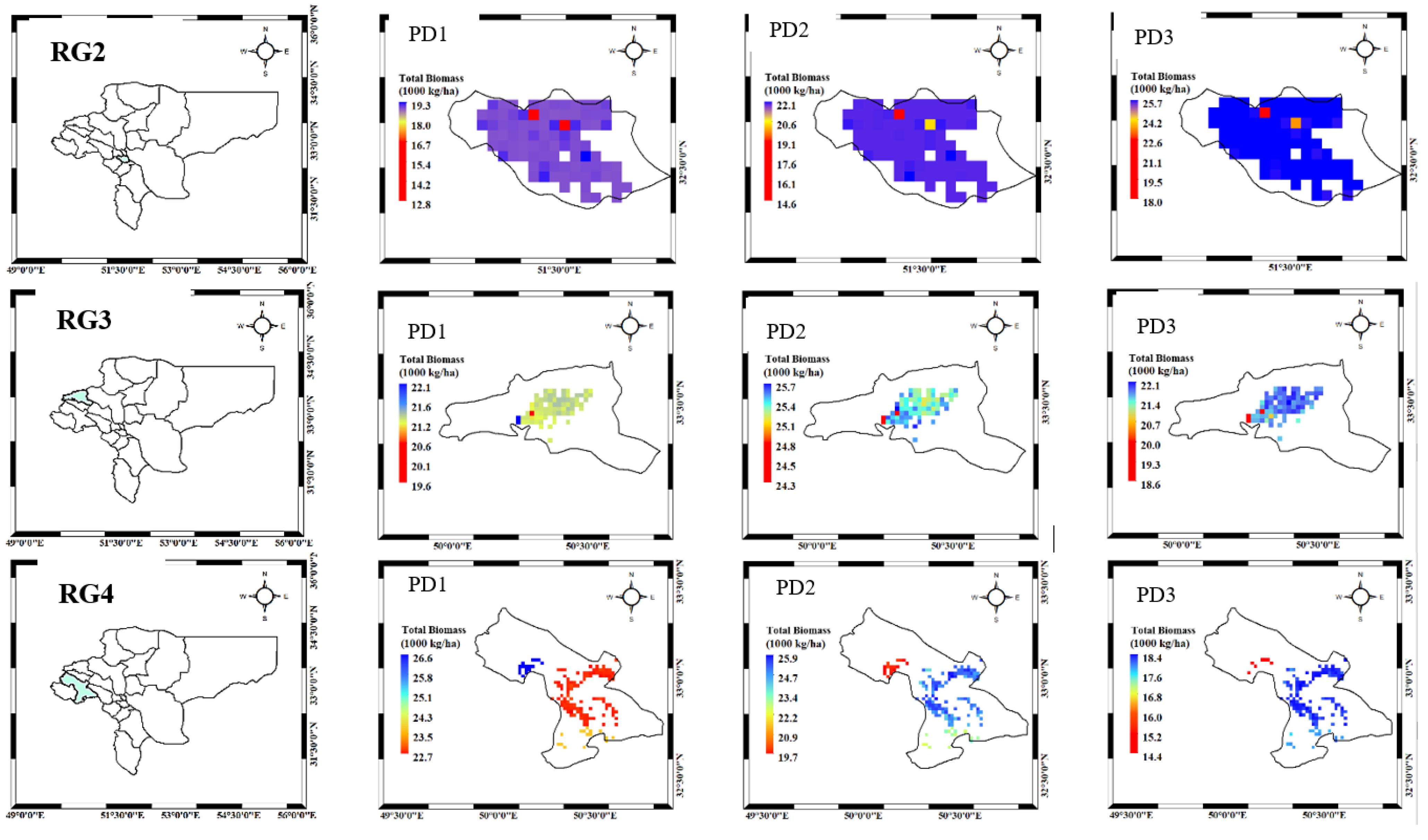
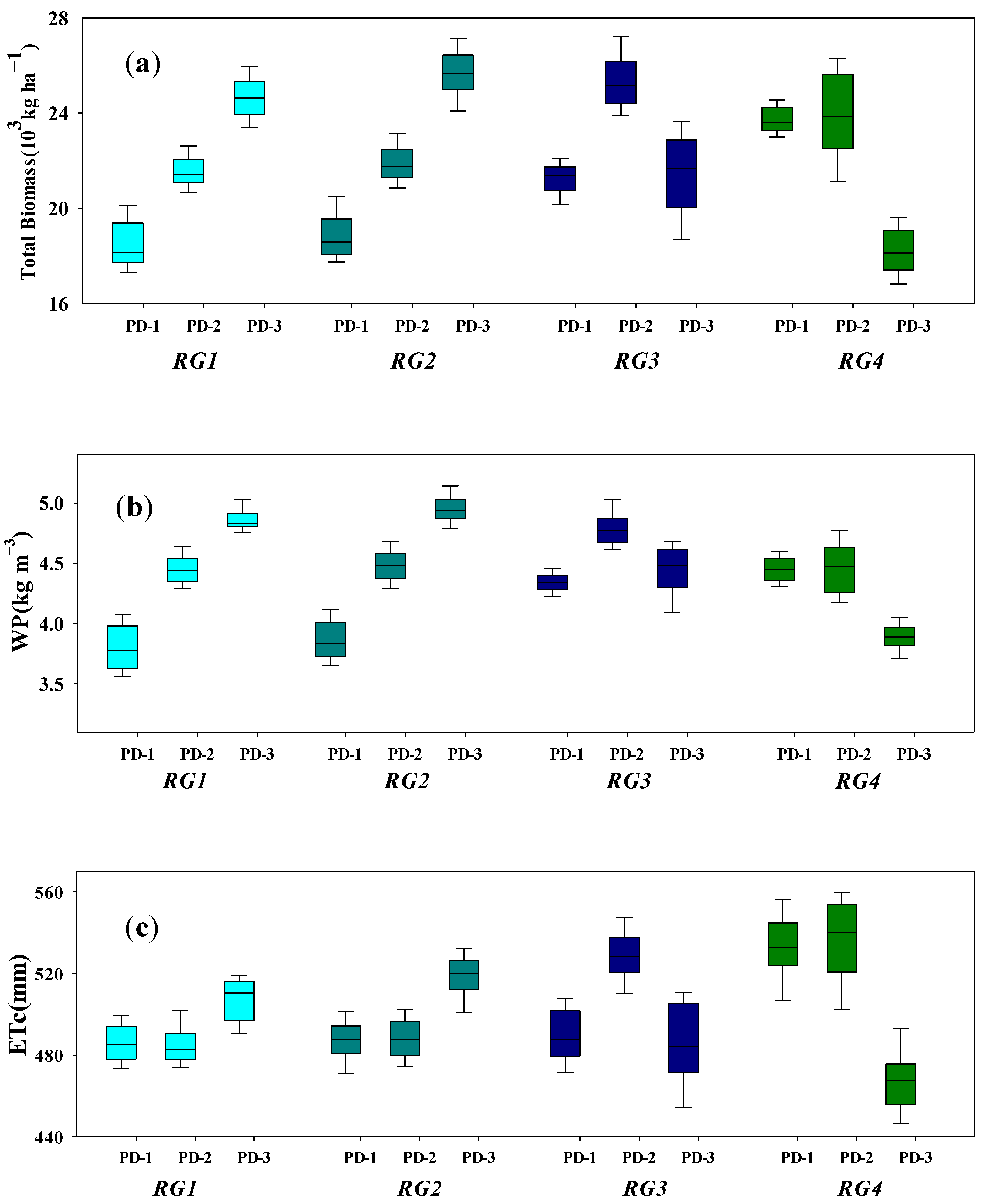
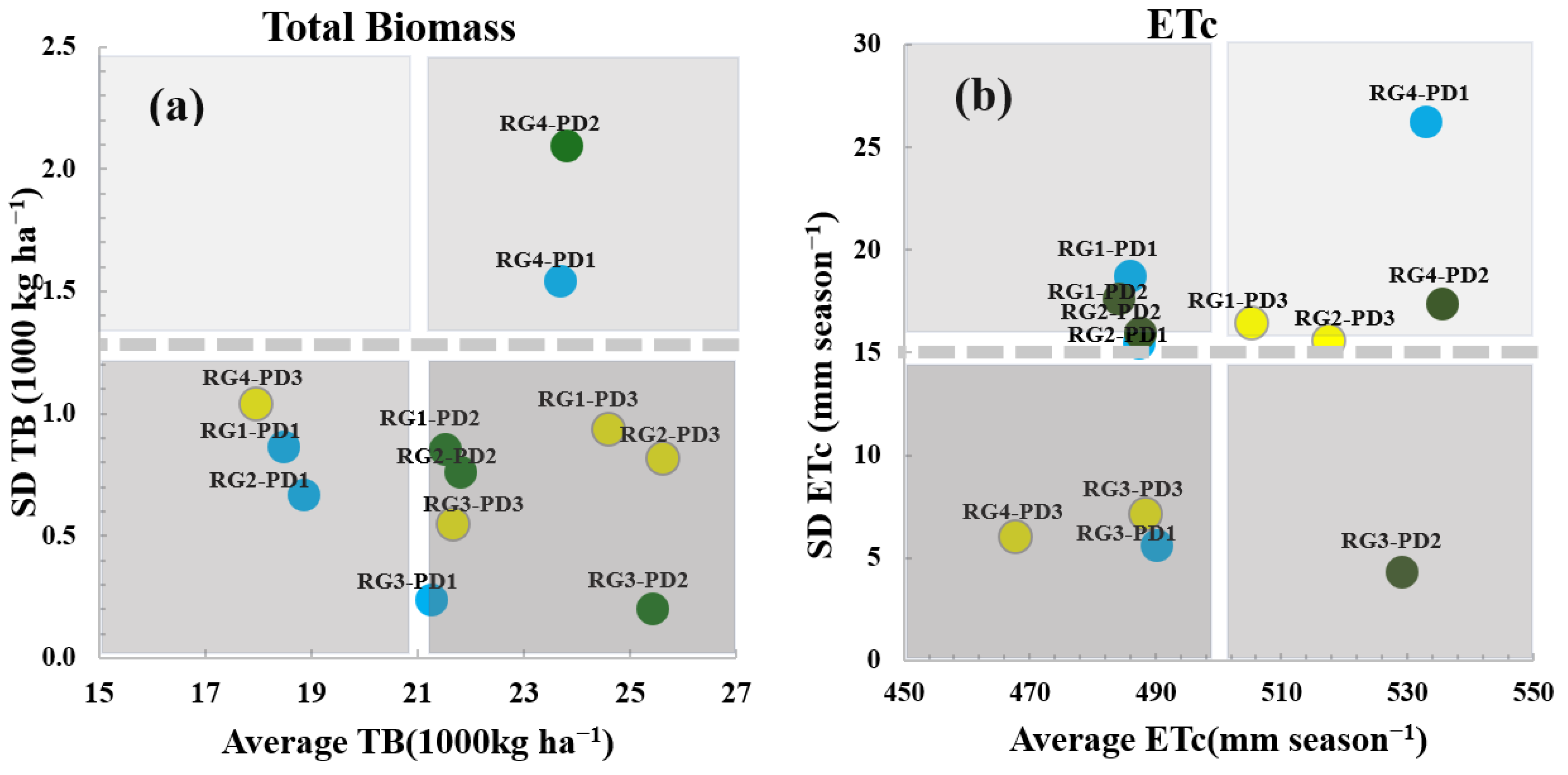
| Index | Planting Date | RG1 | RG2 | RG3 | RG4 |
|---|---|---|---|---|---|
| TB (1000 kg ha−1) | PD-1 | 18.5 ± 0.86 | 18.9 ± 0.67 | 21.3 ± 0.24 | 23.7 ± 1.54 |
| PD-2 | 21.5 ± 0.85 | 21.8 ± 0.76 | 25.4 ± 0.20 | 23.8 ± 2.09 | |
| PD-3 | 24.6 ± 0.93 | 25.6 ± 0.81 | 21.7 ± 0.55 | 17.9 ± 1.04 | |
| ETC (mm season−1) | PD-1 | 486 ± 19 | 487 ± 15 | 490 ± 5.7 | 533 ± 26 |
| PD-2 | 484 ± 18 | 488 ± 16 | 529 ± 4 | 536 ± 18 | |
| PD-3 | 505 ± 16 | 518 ± 16 | 488 ± 7 | 468 ± 6 | |
| WP (kg m−3) | PD-1 | 3.80 ± 0.10 | 3.87 ± 0.04 | 4.34 ± 0.04 | 4.44 ± 0.07 |
| PD-2 | 4.45 ± 0.06 | 4.47 ± 0.04 | 4.81 ± 0.04 | 4.44 ± 0.26 | |
| PD-3 | 4.86 ± 0.07 | 4.95 ± 0.05 | 4.44 ± 0.07 | 3.89 ± 0.08 |
| Planting Date | Planting Date | RG1 | RG2 | RG3 | RG4 |
|---|---|---|---|---|---|
| PD1 | PD2 | 0.000 ** | 0.000 ** | 0.000 ** | 0.842 ns |
| PD3 | 0.000 ** | 0.000 ** | 0.436 ns | 0.000 ** | |
| PD2 | PD1 | 0.000 ** | 0.000 ** | 0.000 ** | 0.842 ns |
| PD3 | 0.000 ** | 0.000 ** | 0.000 ** | 0.000 ** | |
| PD3 | PD1 | 0.000 ** | 0.000 ** | 0.436 ns | 0.000 ** |
| PD2 | 0.000 ** | 0.000 ** | 0.000 ** | 0.000 ** |
| Region | Average Total Biomass (1000 kg ha−1) (Ref. [62]) | Average Total Biomass (1000 kg ha−1) (pSIMS Result) | Relative Changes (%) |
|---|---|---|---|
| Isfahan (RG1) | 26.4 ± 3.2 | 24.6 ± 0.93 | 6.8 |
| Golpayegan (RG3) | 26.3 ± 3.3 | 25.4 ± 0.20 | 3.4 |
| Region | Average Total Biomass (Farmer) | Modified Average Total Biomass (pSIMS Result) | Gap Yield (1000 kg ha−1) |
|---|---|---|---|
| RG1 | 17.3 | 24.1 | 6.8 |
| RG2 | 13.8 | 25.1 | 11.3 |
| RG3 | 11.9 | 24.9 | 13 |
| RG4 | 14.9 | 23.3 | 8.4 |
Disclaimer/Publisher’s Note: The statements, opinions and data contained in all publications are solely those of the individual author(s) and contributor(s) and not of MDPI and/or the editor(s). MDPI and/or the editor(s) disclaim responsibility for any injury to people or property resulting from any ideas, methods, instructions or products referred to in the content. |
© 2023 by the authors. Licensee MDPI, Basel, Switzerland. This article is an open access article distributed under the terms and conditions of the Creative Commons Attribution (CC BY) license (https://creativecommons.org/licenses/by/4.0/).
Share and Cite
Ghobadi, M.; Gheysari, M.; Shayannejad, M.; Dokoohaki, H. Analyzing the Effects of Planting Date on the Uncertainty of CERES-Maize and Its Potential to Reduce Yield Gap in Arid and Mediterranean Climates. Agriculture 2023, 13, 1514. https://doi.org/10.3390/agriculture13081514
Ghobadi M, Gheysari M, Shayannejad M, Dokoohaki H. Analyzing the Effects of Planting Date on the Uncertainty of CERES-Maize and Its Potential to Reduce Yield Gap in Arid and Mediterranean Climates. Agriculture. 2023; 13(8):1514. https://doi.org/10.3390/agriculture13081514
Chicago/Turabian StyleGhobadi, Mahboobe, Mahdi Gheysari, Mohammad Shayannejad, and Hamze Dokoohaki. 2023. "Analyzing the Effects of Planting Date on the Uncertainty of CERES-Maize and Its Potential to Reduce Yield Gap in Arid and Mediterranean Climates" Agriculture 13, no. 8: 1514. https://doi.org/10.3390/agriculture13081514
APA StyleGhobadi, M., Gheysari, M., Shayannejad, M., & Dokoohaki, H. (2023). Analyzing the Effects of Planting Date on the Uncertainty of CERES-Maize and Its Potential to Reduce Yield Gap in Arid and Mediterranean Climates. Agriculture, 13(8), 1514. https://doi.org/10.3390/agriculture13081514







